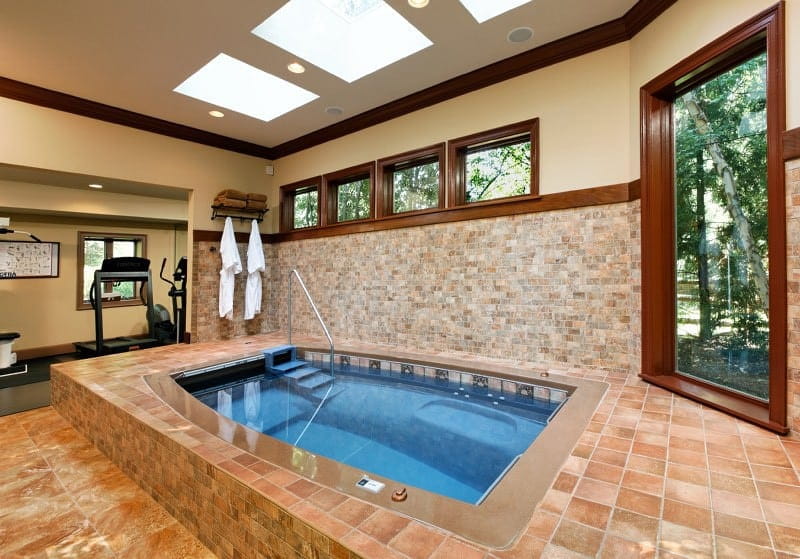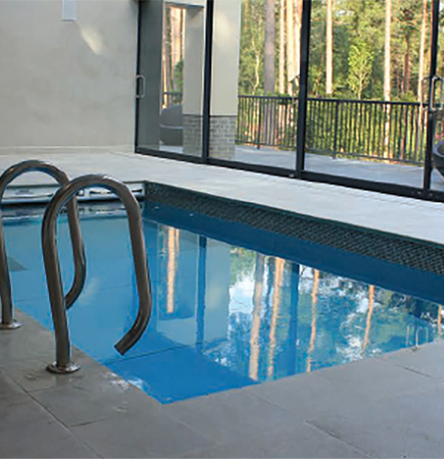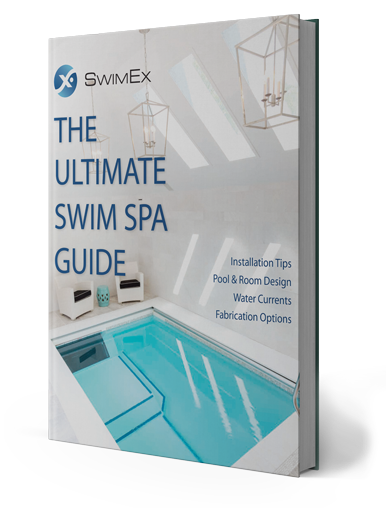Fiberglass Pools Pros and Cons
When deciding what kind of small pool to buy for your home, one of the most important factors to consider is the construction material. Is it a fiberglass pool, gunite, acrylic, or does it have a liner? The type of material your swim spa is built with will determine its durability and strength, the number of years your pool will hold up, the amount of maintenance it will require, and the flexibility of customization and design elements.
Therefore, you will want to do a bit of research. Fiberglass pools are a popular small pool choice. We’re going to explore the various pros and cons of installing this type of pool, as well as make comparisons with gunite, acrylic, and liner pools.
Ultimate Swim Spa Guide
Are fiberglass pools the best choice?
Pros
Easy to maintain
Structurally speaking, fiberglass shells are impervious to normal wear and tear, as well as elements like sun and harsh weather. The result: they will not need major repairs down the road. For extra endurance and installation flexibility, SwimEx fiberglass pool shells are built like the hull of a boat with a gel coat finish – a smooth and shiny surface that makes for easy cleaning and minimal maintenance.
Gel coats are also skin-friendly. If you rub against it while you’re swimming or exercising, you will glide smoothly over its velvety surface. A non-skid application is applied to places where you need to grip, like stairs and walkways.
It’s hard for algae to adhere to the smooth gel coat surface, which diminishes nasty algae blooms and makes it easier to control this perennial nuisance. This means you won’t have to scrub the walls.
There are also no minerals in fiberglass like there are in gunite or cement and nothing that will interact with and affect the water chemistry. This means that balancing the water is much easier.
Installation flexibility
If you’re looking for a quick install, fiberglass swim spas can be up and running in as little as 2-3 days. The shells come pre-built, and once the room is prepared, installation is simply a matter of delivering the shell and connecting the plumbing. You’ll be swimming, exercising, and relaxing in your own home in no time!
Whether you’re starting a new construction or want to fit a pool into an existing space, fiberglass pools can be built to meet your needs. You can order them in our standard sizes or work on a custom one with our team. A 12’ x 20’ area is needed for most of our pools. Imagine putting a pool almost anywhere? Think of adding one to a deck, in the backyard, on a patio, or anywhere else you dream up. Because the fiberglass is lightweight, you can even install them on upper floors or balconies. And if you choose to buy a swim spa with a water current feature, you can still enjoy all the benefits of a full-sized pool in a fraction of the space.
What if you want something larger but don’t have the access to get the pool into the space? Swim spas made out of fiberglass can be delivered in sections and built on-site. Plus, our fiberglass pools are self-supporting. This means you have the option to install them above ground, in the ground or partially above ground, and as an indoor pool or outdoor pool
Customization potential
Pools made from fiberglass are highly customizable, so you’re not tied to pre-existing interior layouts, colors or pool tile combinations. The interior of the pool can be custom-built with steps (a convenient option, particularly if you want to use your pool for aquatic exercises), seats, deep wells, platforms, colors, and more. Match your pool’s interior walls and coping to your home decor. Then pick out coordinating tiles, and you end up with an oasis which perfectly suits your design aesthetic.
Endurance and longevity
Fiberglass lasts. This is a fact that shouldn’t be taken lightly. Unlike other types of pool that need replastering or vinyl liners replaced from time to time, this isn’t necessary with fiberglass pools. In fact, they last so long, people sometimes take them when/if they move. There are even cases where people have gifted their pool to have it installed somewhere else.
Cost friendly and environmentally friendly
Once you’ve installed your fiberglass swim spa, you’ll see that you buy fewer chemicals and it costs less to heat than a traditional pool. Most fiberglass is insulated. Sometimes, as with our pools, it is constructed with a solid wood core. This makes for superior temperature retention. In addition, the gel coat acts as a barrier against moisture absorption, so you’ll fill your pool less often. All this adds up to a pool that’s better for the environment and your wallet.
Cons
Size and shape limitations
Pools constructed with fiberglass can sometimes be limited when it comes to shape and size, depending on the molds the manufacturer uses.
Installation expertise
Installers familiar with gunite and cement pools are much more prevalent in the pool installation market. And sometimes the process needed to install fiberglass can vary from dealer to dealer. If you choose a fiberglass pool, make sure the company that makes the pool has an experienced installer who knows what’s needed to make it operational.

Fiberglass vs gunite pools
The construction of fiberglass pools and gunite pools is so different it’s hard to claim if one is better than the other. While fiberglass and gunite can cost the same initially, the difference lies in expenses incurred post-construction. These include maintenance costs, chemical needs, and repairs down the road as the pool ages.
Gunite pool pros and cons
Pros
If you are looking for a specific shape, an extra-large or extra deep pool, gunite is great for this. If you want features that include built-in rock formations, pond-like looks, waterfalls, etc, gunite goes much further in this direction than fiberglass. Although fiberglass can be made to look natural and can be ordered in many different colors, there are limitations.
Cons
- Gunite pools can incur expensive repairs as they age.
- They require much more maintenance on a weekly basis, such as higher chemical demand and more frequent vacuuming.
- Gunite walls, typically made of porous materials, can be a breeding ground for algae.
- Gunite can be rough to the touch on feet, hands, and if scraped up against.
- Gunite installation is much more complicated. As all the work is done on site, it can take weeks or months to complete.
Acrylic and liner pools – pros and cons
What is an acrylic swim spa?
An acrylic pool shell is common for many pools, hot tubs, and swim spas. It is usually a lower cost option, but may require upkeep and recurring maintenance. Acrylic pool quality depends on how thick the acrylic layer is, as well as what material makes up the substructure. Acrylic swim spa pools with a hand-rolled fiberglass substructure are considered highest quality and more durable.
Pros
Quick installation.
Cons
Difficult to repair and prone to damage in the sun.
What is a vinyl liner swim spa?
The vinyl liner sits between the pool structure and the water. Smooth vinyl liners are fairly flexible when compared to concrete, which can easily crack.
Pros
- Often less expensive up front.
- Customizable shape and size. You can also build in waterfalls, hot tubs, and a variety of features.
- Liner feels smooth to the touch.
Cons
- High recurring costs. Even the more popular vinyl liner pool brands do not offer lifetime guarantees on their pool liners. On average, homeowners reported spending over $1700 each time the liner needs to be replaced. Be sure to read the fine print!
- Vinyl liners and some hydraulic motors typically need to be replaced every 5-7 years. These costs can add up over time.
- Most vinyl liner pools usually only have a thickness of 20-30 mm. Keep this in mind especially if you have children or pets or will keep the pool outside where it will be exposed to the elements.
FIND THE RIGHT POOL FOR YOUR HOME
Searching for the perfect pool? Simply answer a few questions about your preferences and instantly get your tailored pool recommendations.

